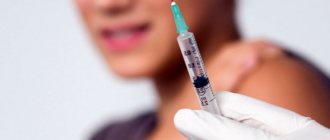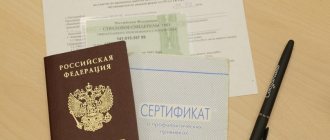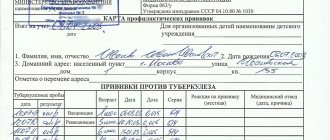Over the period of its existence, humanity has accumulated in its arsenal a mass of dangerous and sometimes incurable diseases, most of which are infectious. Therefore, the problem of vaccination against the most serious and endemic infections has not lost its relevance to this day. However, when proposing to carry out this or that manipulation to acquire immunity, it is necessary to display the information in certain documents. Registration form 156/u-93, called a vaccination certificate, helps with this. Information on required vaccinations is also available on the vaccination card - f. 063/у. These documents are approved in the relevant orders and are equivalent.
Vaccination history from birth and throughout life
In the same way as an outpatient card or medical history is created, a vaccination history is drawn up in medical institutions. Such a document is very important, and information is entered into it almost from the first days of life.
So, even before being discharged from the maternity hospital, the newborn is vaccinated against tuberculosis infection and hepatitis B. Then he will be observed by a pediatrician and a nurse at his place of residence, and information about the preventive injections performed will be transferred to the appropriate children's clinic. In her vaccination office, a card is created in which data on all vaccinations is entered, indicating the date, name and type of vaccine, number, etc. Injections and other measures for preventive purposes are certified by the signature and personal seal of the doctor.
Attention! If young parents have questions about vaccinating their babies, they should contact the maternity hospital or clinic for a certificate of vaccinations.
Being still quite a baby, the baby does not go to a nursery or other institution, and all manipulations are carried out during a visit to the clinic. When registering their child for kindergarten, parents go to the clinic. They create form 030/у, which contains information about vaccinations. Next, the grown-up child is sent to school, and at the same time medical documentation is transferred. From there, the materials go to the adolescent office and, upon reaching 18 years of age, to the clinic for adults.
Children's institutions are served by health workers (doctors and nursing staff) who are associated with the outpatient service where the baby is registered. Information about vaccinations is contained in several documents: it is identical and, for convenience, is duplicated in the vaccination certificate, f. 030/u, for girls - in the antenatal clinic, for boys - in the papers of the regional military registration and enlistment office.
Over the past decades, another format has been approved that is more convenient for the population: a vaccination certificate. This will be discussed below.
Is it possible to restore a vaccination certificate?
The law allows for repeated issuance, but the procedure is complicated and you will have to visit clinics multiple times.
How to recover:
- For adults - go to a children's medical institution where the person was observed until he was 18 years old. The archive stores information about administered vaccines. After the request, the data will be sent to the therapist, who will transfer it to a new passport and certify it with a seal.
- For children, come to the clinic with a blank form. The information will be transferred from the outpatient card, the relevance will be certified by a visa and stamp.
The final stage of restoring the medical book is verification and signature of the clinic’s chief physician.
Vaccination certificate: purpose, convenience, what kind of information it contains
First of all, the child needs a certificate so that parents do not have any difficulties when registering for preschool and school institutions, sanatoriums, and holiday camps. Well, timely vaccinations, reflected in the certificate, will protect the baby from dangerous diseases.
Important! The certificate contains information about vaccinations. The following institutions have the right to issue items: outpatient clinics for children and adults, medical units, health centers, etc.
What is this – a vaccination certificate? The form, approved by the standards of the Ministry of Health of the Russian Federation, contains several sheets of A5 format:
- The first (title) page contains the child’s last name, first name, patronymic, his place of residence, indicating the address and contact numbers of the parents. Information about blood group and Rh is also recorded there. A stamp and a round seal are placed here. A separate column provides brief information about the standards of vaccinations and certification of medical devices.
- The second and third: like the subsequent ones, are presented in the form of tables. They contain columns about the current state of health of the child or adult, the presence of allergic conditions to the administration of vaccines, concomitant pathologies and contraindications, and the dynamics of the Mantoux test. This is followed by information about BCG (for tuberculosis) and protection against polio. The information is certified by the signature of the responsible person and the seal.
- Fourth and fifth: they contain information about injections that protect against whooping cough, diphtheria and tetanus. The table shows the names of injections that are not mandatory, but are performed according to indications in emergencies in limited areas. This is parvovirus, influenza.
- Sixth and seventh: filled in in case of endemic situations, taking into account the specifics of a particular area. Includes information about vaccination against mumps.
- Eighth: information about detected antibody titers (if any), intolerance to certain types of vaccines, existing contraindications, as well as the consequences of previously administered vaccinations.
- Ninth: contains columns on procedures against measles, mumps, rubella, hepatitis types “A” and “B,” and pneumococcal lesions.
The data is entered into the certificate by a specially trained and trained healthcare worker, who often also performs the injections.
Detailed data about the drug is entered into the required rows of the tables:
- name of the vaccine;
- series and number, expiration date;
- the number of milliliters in the administered dose of the drug;
- the corresponding number in dilution if the vaccine is in “dry” form (proportions).
The data is signed by the doctor and certified by the seal of the head physician.
Attention! A vaccination certificate is a personal official document of an individual, and, like a passport, is kept with him and not in a medical institution.
Contents of the official document
If the vaccination certificate is lost, you need to re-do it, which will display the form:
- Personal information. Additionally, there is a column where the patient’s blood type and Rh factor are indicated, as well as information about the clinics where the vaccination was given.
- Sheets 2-3 are tables showing the person’s condition on the day of vaccination, contraindications, diseases, reactions to drugs. Note: Mantoux, test for tuberculosis, polio.
- Sheet 4-5. If you do not have a vaccination certificate, which will not allow you to display data on the samples taken, you need to re-test for: whooping cough, diphtheria, tetanus. Additionally, there is information about vaccines against infections and influenza.
- Sheet 6 - confirmation of endemic vaccinations, which are needed in some areas.
- Pages 8 - data on the presence of antibodies, previous tests and contraindications to such.
- Sheet 9 - vaccines against rubella, mumps, hepatitis, measles.
A doctor or nurse in the clinic at the place of registration of the patient has the right to fill out the form.
Contribute:
- Name of the vaccine.
- Volume of injected product.
- Serial number of the ampoule.
- The proportion is liquid - if the drug is pre-dissolved.
The recording is certified by the doctor’s visa and the wet seal of the head physician of the clinic. A book is a document that every person should keep, just like a work permit and a passport. The form is lost, but it urgently needs to be restored; it’s easier to buy a completed vaccination certificate.
Why do you need information about vaccinations?
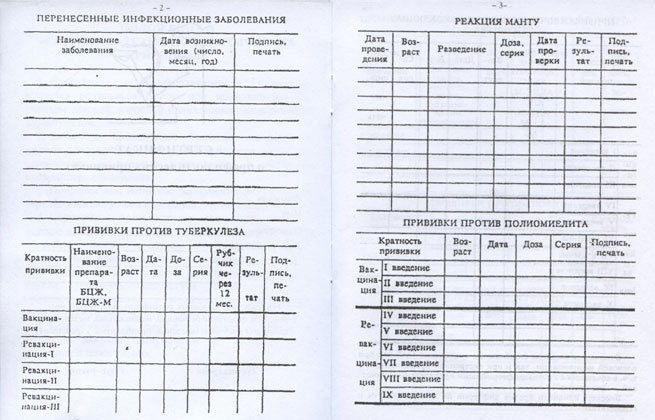
As a rule, any person is engaged in one form of work or another. For some, it is associated with work in epidemiologically hazardous areas, when a healthy body and specific immunity are especially required.
If a person applying for a job has a vaccination certificate in his hands, then obtaining a medical book will not take much time and will not be difficult. The main thing is that the appropriate injections and manipulations are performed on time, and information about them is correctly entered into this document.
How to restore a certificate
The vaccination document may be lost (during a move, theft, fire) or damaged. In this case, it will have to be restored.
The procedure is the same as when preparing a primary document. So you can’t do without visiting a hospital (or several medical institutions). If all information about vaccinations is stored in one place, it will take no more than 3 days to restore the document.
You can speed up the procedure if you have a copy of the certificate certified by a notary. Therefore, after receiving the vaccination book, it is recommended to make a copy of it and keep it at home.
Requirements
You must first study the reminder about the sequence and forms of filling out the vaccination certificate located on the first page. Next, the health worker, guided by information from the primary source about vaccinations, will transfer the names of preventive vaccinations, filling out the data clearly in accordance with the columns.
Important! The issued certificate has the same legal significance as the corresponding card or vaccination certificate. Other certificates may be issued on its basis.
A properly executed paper is an individual document of this particular person and is stored in his hands, and not in a medical institution. There is no need to paste a photo there.
What it is
The new document contains information about all vaccines received by a person throughout his life and is a guarantee that they will not be vaccinated again (erroneously). But the certificate is needed not only for this.
Without vaccination information it is impossible to:
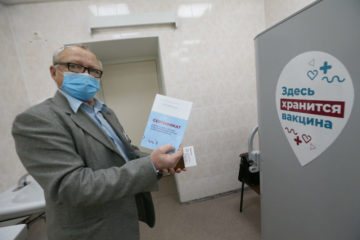
- register the child in a preschool or general education institution;
- enter university;
- get a job (especially in catering establishments or positions with increased workload);
- undergo military service (primarily contract service);
- travel to Africa, New Zealand, South America and other countries where there are often epidemics of diseases that can be protected from by vaccinations;
- undergo rehabilitation in a sanatorium, medical hospital.
Previously, information about vaccinations was recorded in the corresponding cards of form 063/u. In terms of content, this document is no different from the new sample (156/u-93). Both the vaccination card and the certificate are legally considered equivalent.
The difference is that the card is stored in the clinic to which the child or adult is assigned. A certificate is a personal document issued to a person.

Vaccination certificates for newborns are issued upon discharge from the perinatal center. At the request of parents, for older children, a document is issued at the clinic at the place of residence (this is done free of charge).
There are situations when a certificate is urgently needed, and the medical institution that stores information about vaccinations has run out of forms.
You can purchase a blank document at places where printed materials are sold or download it from the Internet and print it out.
It’s better to get a certificate sooner than to regret wasted time later

While the baby is with his parents, the issuance of the certificate is usually delayed. However, at the age of 18, young people's opportunities increase and their intentions may change. This is usually due to:
- travel outside the region, for example, a business trip to foreign countries (Africa, South American countries) with unfavorable epidemiological conditions;
- registration for studies, catering or harmful working conditions;
- military service;
- treatment in sanatorium conditions, hospitalization.
For young children, the issue of a certificate remains relevant when registering for kindergarten, school, or children's camp.
In the above cases, data on preventive vaccinations is always required. This procedure takes a long time. In addition to the fact that a significant part of it is spent on moving, the process of obtaining information is also delayed. The vaccination card is archived. It takes time to request it and process the actual vaccination certificate. As a result, the time spent on this kind of “red tape” becomes the culprit for a lost good position, missed vacation on a voucher, and the inability to enroll and start studying.
Why is the document needed?
The vaccine passport informs not only about all preventive vaccinations, but also about the characteristics of the body, the state of immunity, so you may need:
- When traveling to exotic countries - when opening a visa to South America, Africa, New Zealand, and other countries.
- For job applicants - mandatory for the food sector, education, and for persons who will be exposed to hazardous working conditions and increased stress.
- For young children - admission to school, kindergarten, development centers, summer camp.
- For applicants - university, school, college, academies, lyceums.
- Hospitalization in a hospital.
- Service in the armed forces.
There are requirements for filling out the passport: blots, cross-outs, and illegible entries are not allowed.
What to do when the certificate is irretrievably lost or damaged?
There are situations when a much-needed vaccination certificate is lost: it is taken out along with a cosmetic bag, purse, etc., or it becomes unreadable and becomes unusable due to some reason. There is a way out, and more than one.
The first option, which takes longer, is to contact a clinic or other medical institution at your place of registration that has this data.
The second is when a copy of this certificate remains. One feature: it must first be certified with a signature and the appropriate stamp. It is advisable to do this in advance, when the certificate has not yet been lost, otherwise difficulties may arise. Moreover, it is not necessary to contact a notary, but do everything with the help of a specialist in the human resources department at your place of work or an employee of the medical institution who issued the certificate.
What difficulties do you encounter when obtaining a certificate?
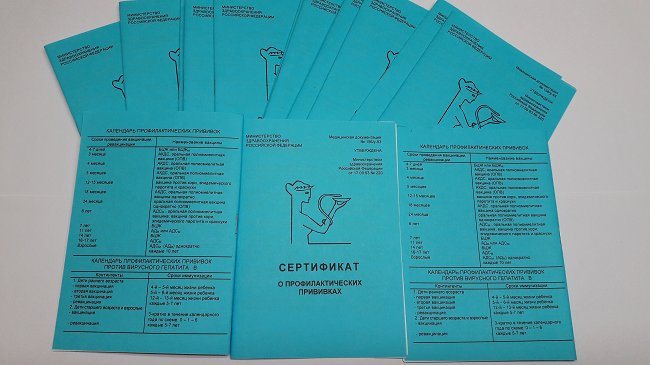
Often a person applies for the issuance and execution of a certificate, but the hospital simply does not have the appropriate forms. The problem is easily solved: you can go to the nearest medical center and purchase it there. Blank forms are sold at newsstands and any office supply stores. It can be printed on a printer: samples of such forms are easy to find on the Internet.
How much does registration cost?
A passport for vaccinations done in public medical institutions is provided free of charge. All you need to do is purchase a blank form at a print kiosk. It costs between 30-40 rubles.
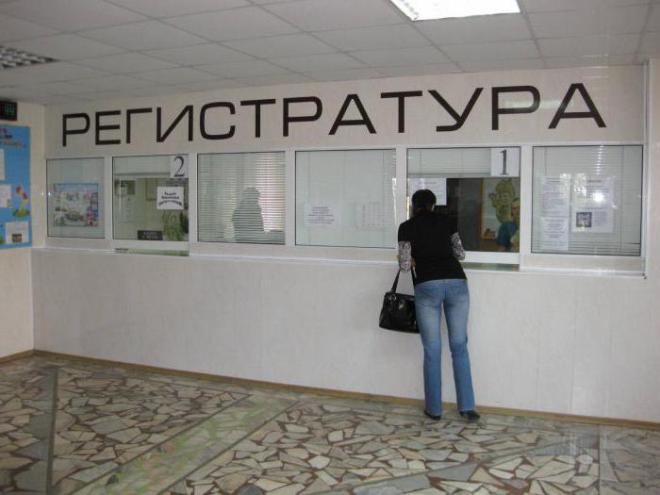
As for private medical centers, the fee for document processing varies widely. It depends on the status of the clinic and the list of required vaccinations. Price – from 1000 rubles.
Where to get a vaccination certificate depends entirely on the desire of the person. He can go to a public or private medical institution. The main thing is that a license to carry out vaccination procedures is issued. You should not trust those who claim that they will complete the document without administering vaccines. In this case, a person risks his health, and in some cases his life, if there is a high probability of becoming infected with dangerous viruses or bacteria in the region.

